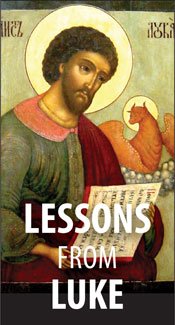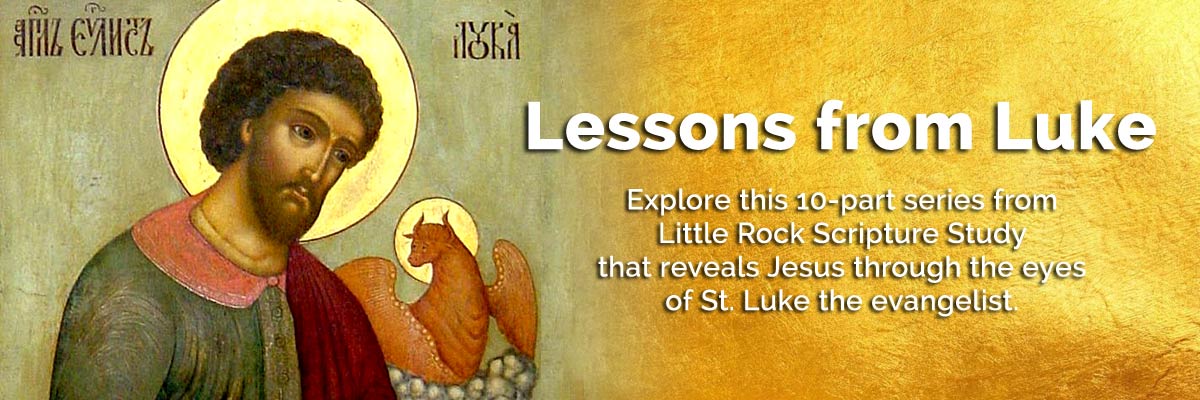Official Website of the
Catholic Diocese of Little Rock
Jesus reveals God’s generosity
Published: June 15, 2019
This is the fifth column in a 10-part series.
By Cackie Upchurch
Director of Little Rock Scripture Study
“Who do you say that I am?” This question is the heart of the Gospel. It is the question Jesus asks each of us, just as he asked his first followers (Matt 16:13-20; Mark 8:27-30; Luke 9:18-21). Each evangelist tried in some way to answer the question of Jesus’ identity personally, and for the community he was originally addressing. They had all experienced the same man, heard the same teaching, accompanied him in the same series of events, and yet each evangelist offered something slightly unique. It is as when a sculpture is unveiled and each viewer appreciates some aspect of that piece in a particular way. The sculpture is the same; the impact is unique.
Each evangelist tried in some way to answer the question of Jesus’ identity personally, and for the community he was originally addressing. They had all experienced the same man, heard the same teaching, accompanied him in the same series of events, and yet each evangelist offered something slightly unique. It is as when a sculpture is unveiled and each viewer appreciates some aspect of that piece in a particular way. The sculpture is the same; the impact is unique.
Readers often describe Matthew’s Jesus as the great teacher and fulfillment of expectations, Mark’s as the suffering Messiah, and John’s as the divine Son of God. These portrayals may be somewhat oversimplified but they do acknowledge the varieties in emphasis. What do we notice about Luke’s portrayal of Jesus? Who does Luke say that Jesus is? And how does Luke reveal it?
When reading the third Gospel, and hearing it proclaimed as we are during this liturgical year, we can appreciate the image of Jesus that emerges: Savior of the world and compassionate healer. These descriptions have something in common — generosity. The generosity of Jesus, his graciousness in extending himself to others, and even giving his very self, shines through the Gospel of Luke.
Mary’s prayer or canticle while she was pregnant with Jesus, the Magnificat (ch. 1), extols God’s care for those who have no voice. Jesus’ own adult ministry is launched with similar language in his proclamation of the words of Isaiah in his hometown synagogue in Nazareth (ch. 4). There he proclaims that in him the time is fulfilled to bring glad tidings to the poor, liberty to captives, sight to the blind, and freedom to the oppressed. These two pieces set the tone of Jesus’ mission to those on the margins of society.
Jesus embraces and heals all kinds of people whose conditions classified them as “unclean,” setting them outside the warm relationships of the community. He heals lepers and paralytics (5:12-14; 17-17-24), expels demons from those tormented by evil (6:18; 9:37-43), pardons a woman whose sinful reputation is known by all (7:36-50), cures a woman who has hemorrhaged for years and brings life to a child reported to be dead (8:40-456), heals a man suffering from dropsy (14:1-4), and restores sight to the blind (18:35-43).
When he teaches, his parables also emphasize his generosity. His stories reveal that his mission is for those on the margins, those who are lost or have been ignored. We see this in chapter 15 with the parables of the lost sheep, the lost coin, and the lost son. We have a sense of this broader kind of inclusion in the parable of the feast that brought in people who were cripples, blind and lame (14:15-24). Jesus draws children to himself, and uses them to teach about the attitude required for those bound for God’s kingdom (18:15-17).
In the Gospel of Luke, written some forty or so years after the resurrection, we see a portrait of Jesus as one who calls all people into an experience of God’s kingdom. He works wonders for those outside the community of Judaism, or held in low esteem ─ healing the slave of a Roman centurion (7:1-10), dining with tax collectors such as Zacchaeus (19:1-10).
If we continue reading Luke’s second volume, the Acts of the Apostles, we discover that indeed the Gospel is proclaimed not just in the land of Israel, but to the “ends of the earth.” The followers of Jesus scatter throughout the region around the Mediterranean Sea, proclaiming God’s generous love, establishing communities of believers, and ultimately welcoming Gentiles (non-Jews) into the believing community.
For those in Luke’s community, the original hearers of his Gospel, Jesus sets out to gather a people, and they are the beneficiaries of his mercy and healing. They know that his sacrifice in life and in death opens the doors to a faith that is not defined by race, ethnicity, or culture. They experience Jesus as savior of the world, and their witness invites us to do the same.
Study Questions
- When has your experience of Jesus been broadened or deepened by listening to someone else’s experience that may be different from your own?
- Skim through the Gospel of Luke, turning the pages and noting the headings throughout the story. What picture begins to emerge just from this simple practice?
- In what situations have you noticed God’s generosity – in your own life or in the lives of others?
- If you were to answer the Jesus’ question, “Who do you say that I am?” what would you say? How would you describe your experience of Jesus, and has it changed over the course of your life?
This article was originally published in Arkansas Catholic June 15, 2019. Copyright Diocese of Little Rock. All rights reserved. This article may be copied or redistributed with acknowledgement and permission of the publisher.




